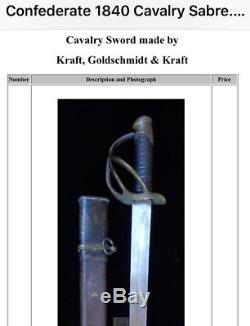Original Civil War 1840 Confederate Cavalry Saber












Model 1840 Heavy Cavalry Saber (Confederate in Origin). Key indication: Missing the distinctive grip bulge as occurs in the Model 1860 Light Cavalry Saber. Unmarked to include any indication of inspector validations. Wire Grip Wrap: Single strand iron (or similar ferrous material).
Federal made sabers used twisted brass wire. Possibly copper, but cannot definitively tell due to patina. Blade: No refined or finished ricasso as demonstrated in all federal made specimens. Unrefined back-edge shows possible signs of expedient work i.
Blade (Fuller): Not as crisp as mass produced Federal examples. Uneven lines and no, well defined, transition between the fuller and the start of the cutting edge.
The darkened and pitted blades appear to be iron and not steel. Federal swords and sabers were made of steel. Lack of a spring feel. Unrefined (machine marked), brass washer (ferrule) between the leather grip and brass d-guard quillon (cross-guard). This is the most unique and distinctive feature.
Quillon (cross-guard): Thinner brass than Federal models. The brass edgework does not demonstrate the slightly convex refinement found on Federal swords or European imports. The bent quillon occurred after manufacture. Pommel Peen (Tang): Not a strong indication, but the peen in this example differs greatly from mass produced (machined) examples.
The peen is rough and does not flow smoothly into the brass. However, it is highly probable that the saber had been re-peen at a later date. One may also argue that the rough peen was due to time and resource constraints during the war (no time for refinement). Peen not centered on pommel cap. Lack of Federal Inspector Marks: Completely void of finishing marks, proofs and acceptance stamps. Two Possible Manufactures: The key indicator is the brass washer (ferrule) mentioned above. 1 Kraft, Goldschmidt & Kraft (KG & K) of Columbia, SC. Key Trait of Both Manufactures: Both supplied with wooden scabbards. There has been much speculation over the years as to the maker of this wooden sheathed sword. In William Albaughs 1963 work, A Photographic Supplement of Confederate Swords, he speculates that it is a product of Kraft, Goldschmidt and Kraft of Columbia, South Carolina; based on the long, nearly straight blades, brass ferrule at the base of the grip and small gauge wire used in winding the grips of both swords. Later discoveries had confirmed his supposition.However this pattern is still frequently referred to within the collecting community as having been made by H. I can find no evidence whatsoever for this attribution. The only sword known to have been made by H. Marshall is an exquisite officers sword of the very best quality.
I believe the theory that Marshall made this pattern is untenable. There is a production knife in the South Carolina Relic Room in Columbia, South Carolina, that has a grip and basket identical to the sword shown here, it is identified as having been made in Columbia. Columbia is where the Kraft, Goldschmidt, Kraft sword factory was located. The knife and this pattern sword share several features with the K, G & K officers swords: a wire grip winding of small diameter, and leather grip wrap made of inferior material, consequently most are missing the wrap. All have brass ferrules at the base of the grip like the K, G & K officers swords.
Douglas produced a cavalry sword that utilized an identical wooden scabbard. Very long and crudely produced saber with wide wooden scabbard. These sabers were believed to have been made by the H.
Marshall firm of Atlanta, Georgia and has been known for years as the Marshall Cavalry saber. However, the latest research shows that it may have actually been produced by the firm of Kraft, Goldschmidt and Kraft of Columbia, South Carolina. The overall length of the saber itself, without the scabbard is 42.00 inches. 36.50 inches long and is approx. 1 3/16 inches wide at the ricasso.The last 9.00 inches is double edged as it approaches the point. Blade has a wide unstopped fuller that runs approx. Blade is semi-bright with moderate scattered mottling on both sides and minor scattered pitting.
A close inspection of the blade surface will reveal several casting flaws especially in the area of the unmarked ricasso. Edge is free of nicks and shows no signs of having been sharpened.
The hilt has a plain, crudely cast Phrygian style pommel cap devoid of any decoration. It sits atop a grip that is wrapped with black painted coarse canvas and twelve progressions of plain untwisted copper wire ending with a brass ferrule.
The rest of the guard has a three-treed knucklebow ending in the counterguard. All is very plain and crudely made. All brass has a very nice untouched dark patina.
There is some light wear and signs of use on the hilt but nothing that stands out. Overall the hilt is pleasing. The scabbard is made of two pieces of wood fitted together lengthwise causing a vertical seam on each side. There are no cracks or chips.The two mounts and the drag are made of brass japanned black. Each one is attached by several brads, some of which are missing. Top mount includes the throat and is rather large measuring approx. Both mounts have their rings. The wood of the scabbard is stained dark and shows light wear from age, use and storage.
The drag has a dent at center while the two mounts have light surface wear. Marshall Cavalry Saber with Wood Scabbard.
Is known to have made these wood scabbards. Sword has 33-3/4 blade with unstopped, fuller. The blade is gray with no significant dings or rust --just dirt. Hilt is Brass with 3-branches still showing original finish work file marks. The grip is leather covered wood, some showing though with single iron wire wrap.
Scabbard is wood and pinned with copper. Mounts are sheet iron / tin with brass bands.
Kraft, Goldschmidt & Kraft (KG & K) of Columbia, SC is also thought to have made this style sword. A very desirable and classic Confederate made Cavalry Saber. Source 5: Arms and Equipment of the Confederacy (Echos of Glory), Time Life Books, 1998, page 76 H. Source 6: The Ordnance Manual for the Use of the Officers of the United State Army, 3rd Edition, J. This example displays heavy blade pitting and the hilt guard is crushed out of shape.Roughly 12 ¾ of the blade is intact as the remainder broke at one point in it history. Over blade tarnish matches the level of tarnish and patina at the fracture.
Leather grip is dray with missing fragments. Additional high resolution photos available upon request. This is an extremely rare piece of history.
And would make a jaw dropping display piece either in your office, or museum. The item "Original Civil War 1840 Confederate Cavalry Saber" is in sale since Wednesday, February 28, 2018. This item is in the category "Collectibles\Militaria\Civil War (1861-65)\Original Period Items\Edged Weapons". The seller is "mmph19858" and is located in Springfield, Illinois. This item can be shipped worldwide.
- Country/Region of Manufacture: United States

